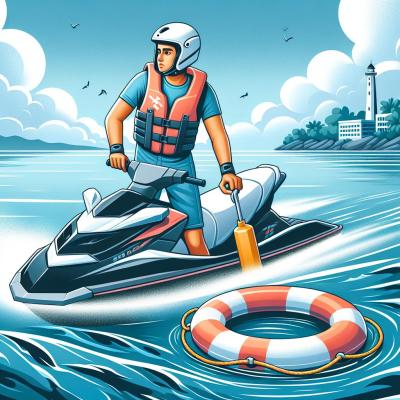This article is dedicated to Jetski enthusiasts who wish to merge thrill with caution, as we highlight the top safety tips to keep in mind. We will delve into precautionary measures that range from pre-ride checks to proper riding etiquette, ensuring you make the most out of your Jetskiing experience while minimizing risks. So, buckle up your life jacket, and let's preview the essential advice that will keep you safe as you make waves.
Understanding JetSki Safety Equipment
The Essentials: Life Jackets, Safety Lanyard, and GPS
JetSki safety starts with equipping yourself with the right gear. A sturdy life jacket should top your list as a non-negotiable item; it's your best ally should you find yourself unexpectedly in the water. Next is the safety lanyard, often referred to as a kill cord, which is designed to immediately cut the engine if you fall off, preventing the JetSki from continuing uncontrolled.
Moreover, navigating the open waters without orientation can be daunting. A GPS device is invaluable for monitoring your location, planning your route, and ensuring a safe return to shore, especially in unfamiliar or vast water bodies.
Personal Floatation Device (PFD): Choosing the Right Type and Fit
Selecting a Personal Floatation Device is not only about comfort but survival. The right PFD must be fit for JetSki use, ensuring it can withstand high speeds and water impact. It should feel snug yet allow you to move freely without it riding up. Remember, it cannot serve its purpose if it isn't worn correctly at all times on the water.
Additional Safety Gear: Waterproof Communication Devices and First Aid Kits
In addition to the essentials, consider packing waterproof communication devices such as a VHF radio or a mobile phone in a watertight case. These can be life-savers in critical situations when you need to call for help. Additionally, a basic first aid kit can address minor injuries immediately, which is particularly handy given the potential delay in emergency services reaching you on open water.
Pre-Ride JetSki Inspection Checklist
Engine and Fuel System Check
Before setting out, a thorough check of the engine and fuel system is essential. This includes examining the fuel level to ensure you have enough for the journey and checking for any signs of leaks or damage. Starting the engine briefly on land can also give you an indicator of its health, allowing you to listen for any unusual noises or mechanical hiccups that could signify a problem.
Hull Integrity and General Maintenance
Inspecting the hull for cracks or damage is critical as even minor breaches can lead to water ingestion and potential sinking. Check the JetSki's underside for any signs of impact or wear that could affect its performance. Furthermore, routine maintenance checks such as ensuring the steering and throttle are responsive, the intake grate is clear of debris, and the impeller is free of damage, are all vital measures for safe operation.
Ensuring Battery Life and Proper Functioning of Electronic Systems
The last thing you want is to be stranded due to a dead battery. Test the battery to ensure it has a full charge and is securely mounted. Electronic systems such as the bilge pump, navigation lights, and digital gauges should be operational. If your JetSki has a security system or electronic ignition lock, test them to prevent any unwelcome surprises during your trip.
Understanding Local Laws and Regulations
Navigating through Licensing Requirements
Every Jetski rider in Australia must be familiar with the licensing requirements set forth by their state or territory. This typically involves passing a boat safety course and obtaining a personal watercraft (PWC) license. Ensure you carry your license with you whenever you're on the water as proof of your eligibility to operate a JetSki. Understand that licensing is not just a formality; it's a way to validate that you've been educated about the appropriate conduct and safety measures on the water.
Speed Limits, No-Go Zones, and Environmental Considerations
Respecting speed limits is not just about obeying the law; it's also about safeguarding your safety and the safety of those around you. Keep informed about the specific speed restrictions in various areas, particularly near swimming zones, marinas, and wildlife habitats. Additionally, be aware of no-go zones where JetSkis are not permitted, which can protect both sensitive ecological areas and ensure your safety. Observing these regulations can prevent collisions, minimize disturbance to local fauna, and help maintain a positive reputation for the Jetskiing community.
Importance of Staying Updated with Local Maritime Authority Guidance
Waterway regulations are subject to change, and it's imperative for JetSki riders to keep abreast of the latest guidance from local maritime authorities. This includes temporary restrictions due to events, weather conditions, and updates to navigational rules. Regularly checking alerts from authorities or joining local JetSki clubs for updates can be an efficient way to stay informed. Abiding by the latest guidance keeps everyone safe and ensures a stress-free ride.
Weather Watch: Planning Around Conditions
Interpreting Weather Reports and Maritime Forecasts
Before you rev up your JetSki's engine, it's essential to understand the day's weather outlook. Accurate interpretation of weather reports and maritime forecasts is not just a skill but a necessity for a JetSki rider. Check forecasts from reliable sources for information on wind speed, wave height, and weather patterns. Pay attention to any warnings issued and understand what they mean for sea conditions, as these can significantly influence your safety on the water.
Avoiding Hazardous Weather: Wind, Waves, and Visibility
High winds can create choppy waters, which are challenging and dangerous to navigate, especially for less experienced riders. Similarly, large waves not only increase the risk of capsizing but also make it difficult for other vessels to see you. Fog and heavy rain reduce visibility, heightening the risk of collisions. Should you encounter sudden changes in weather while riding, it's critical to have a plan of action for seeking shelter or returning to shore safely.
Seasonal Considerations for Australian Waters
Australia's waters can vary greatly depending on the season and location. Northern regions may experience tropical storms and cyclones during summer and autumn months, while southern areas can have cold fronts and strong winds in winter and spring. Understanding these seasonal weather patterns and planning your JetSki adventures accordingly ensures not only your safety but also makes for a more enjoyable experience free from the stress of unexpected weather changes.
Safe Riding Techniques and Maneuvers
Mastering Core JetSki Controls and Handling Basics
Safe and enjoyable Jetskiing begins with a solid grasp of the vehicle controls and handling basics. Familiarize yourself with the throttle, steering system, and braking mechanisms before heading out. Practice these controls in calm waters to build confidence. Emphasize the importance of smooth throttle use to avoid abrupt acceleration, which can lead to loss of control or unintended ejection from the JetSki.
Staying in Control at High Speeds and in Rough Waters
Thrills come with high speeds, but maintaining control is paramount for your safety. When operating at higher velocities, your reactions must be quick and precise. Lean into turns and distribute your weight accordingly to stabilize the JetSki. Rough waters demand even greater attention and skill. Be alert and responsive to the changing conditions, adjusting your speed and handling techniques to navigate safely through waves and choppy water.
Maneuvering Safely Among Other Watercraft and Swimmers
Waterways are shared spaces, and as a responsible JetSki operator, it's critical to be considerate of others. Always keep a safe distance from swimmers, divers, and other watercraft. Stay aware of your surroundings and operate at a speed that allows you to take evasive action if necessary. Avoid making unpredictable maneuvers that could endanger you or those around you, and respect all boating signals and signs to prevent miscommunication and accidents.
Navigating and Environmental Awareness
Respecting Marine Life and Sensitive Habitats
When you're out on the water, remember that you're a visitor in the marine environment. Australian waters are home to diverse and precious ecosystems. It's essential to operate your JetSki in a way that respects the wildlife and their habitats. This includes avoiding areas known for being sensitive or critical to marine life, such as breeding grounds, and reducing speed to minimize disturbance when in proximity to wildlife. Observance of these practices ensures that you can enjoy the natural beauty without contributing to its degradation.
Understanding the Impact of Waves and Wakes on Shorelines
The waves and wakes generated by your JetSki can have a more significant impact than you might realize. They contribute to shoreline erosion, disrupt nesting birds, and can upset the balance of nearshore ecosystems. It is important to minimize this impact by reducing your speed near the shore and following any local regulations regarding wake restrictions. Practicing conscious riding habits not only protects the shoreline integrity but also demonstrates a commitment to preserving the environment for everyone's enjoyment.
Sustainable Riding Practices to Protect Australia's Waterways
Every rider can play a role in safeguarding the environment through sustainable riding practices. This means maintaining your JetSki to prevent oil or fuel leaks, disposing of waste properly, and even participating in or initiating clean-up efforts to remove debris from waterways. Encouraging and engaging in eco-friendly practices contributes to the conservation and longevity of Australia's beautiful waterways, ensuring they remain pristine and accessible for future generations of JetSki enthusiasts.
Safety Courses and Continuing Education
The Benefits of Formal JetSki Safety Training
Embarking on formal JetSki safety training offers a multitude of benefits, including comprehensive knowledge of operational techniques, rescue procedures, and a deep understanding of the rules of the water. Courses are tailored to all skill levels, ensuring that both novices and experienced riders can learn and hone their abilities. By undergoing such training, riders equip themselves with the information and skills needed to react confidently and efficiently to a variety of situations that may occur while riding.
Overview of Courses Provided by Local Australian Organizations
In Australia, a variety of maritime organizations offer safety courses specifically for personal watercraft (PWC) operators. These courses cover a range of topics, including practical handling of a JetSki, navigation, understanding weather patterns, and environmental stewardship. They are generally recognized by authorities and can sometimes be a prerequisite for obtaining a JetSki license. Providers include state-affiliated maritime safety agencies, boating clubs, and private institutions with tailored programs to enhance safety on the water.
Staying Up-to-Date with Safety Standards and Best Practices
The waterscape and associated safety standards are in a state of continuous evolution. As technologies advance and environmental considerations take on greater importance, it's vital for JetSki riders to stay informed. Continuing education is key, and it goes beyond initial qualification. Riders should seek regular updates and refresher courses to stay abreast of the latest best practices, technological improvements, and legal requirements. This commitment to ongoing education not only ensures your safety but also the safety of those with whom you share the waterways.
Handling Emergencies and Unforeseen Situations
What to do if you fall off your JetSki
Falling off your JetSki can be disorienting, but remember, panic is your biggest enemy. First, ensure your safety lanyard has done its job and cut the engine off. Stay with your craft, utilizing it as a flotation device if necessary, and make your way back on board using the re-boarding step or handle. Always wear your PFD (Personal Flotation Device) to aid in keeping you afloat and visible while in the water.
Dealing with Equipment Failure on the Water
Should your JetSki experience a malfunction, remain calm. Assess the situation to determine if it's a problem you can fix, like a tangled tow rope or a simple engine issue. If the problem is beyond immediate repair, signal for assistance with your waterproof communication device. Attach a brightly colored cloth or use hand signals to increase visibility to others. If you're close to shore or a stable structure, consider towing your JetSki to safety, but only if it doesn't put you at greater risk.
Communication Protocols for Rescue and Assistance
Effective communication is essential during emergencies. If you require rescue or assistance, use your VHF radio, set to channel 16, to send out a distress call. Clearly state your situation, location, and the help you need. If using a mobile phone, call the local maritime authority or emergency services. Remember to stay with your craft, as it's more visible than a person in the water. Regularly attend safety course refreshers to stay familiar with updated communication protocols and rescue techniques.
Creating a Safe JetSki Culture
Promoting Safety Within the JetSki Community
Creating a culture of safety among JetSki enthusiasts starts with each individual rider. Promoting a safety-first mindset is crucial and can be achieved through active participation in community forums, social media groups, and at local clubs. Sharing experiences, insights, and lessons learned after each outing can contribute to a collective wisdom that benefits the entire community. Additionally, seasoned riders can lead by example and mentor newcomers to foster a responsible attitude towards JetSki operation.
Responsibility Towards Passengers and Other Water Users
Every JetSki rider holds a responsibility not only for their personal safety but also for the safety of their passengers and other individuals sharing the waterways. It's important to ensure that passengers are briefed on proper behavior, hand signals, and emergency procedures before departure. In the broader scope, riders should always maintain a vigilant watch for swimmers, smaller craft, and wildlife to avoid endangering others. Adhering to rules and regulations is critical, but so is exercising common sense and courtesy in unpredictable situations.
Peer-to-Peer Safety Advice Sharing
Peer-to-peer advice sharing is a powerful tool for improving JetSki safety standards. Engaging in open dialogues about equipment, techniques, and personal experiences can lead to more informed decision-making on the water. Encouraging such exchanges within the community not only enhances individual knowledge but also strengthens community bonds. Local meet-ups, training days, and online forums are excellent avenues for facilitating these critical conversations. As members of the JetSki community share their insights, everyone benefits from the collective commitment to safety and respect for the water.
Conclusion
In this comprehensive guide, we've navigated through the waves of JetSki safety, underscoring the importance of equipment checks, understanding local laws, weather considerations, and mastering safe riding techniques. We've emphasized the significance of proper training, the handling of emergencies, and the creation of a safety-conscious culture within the JetSki community. Each tip provided is a vital component in ensuring that every outing is not just about the thrill, but also about returning safely to shore.
Making safety a priority on every ride is more than a recommendation—it's an imperative. From pre-ride inspections to emergency preparedness, these practices are designed to protect you, your passengers, and the marine environment. Whether you're a seasoned rider or just starting, committing to these safety tips can significantly reduce risks and enhance the enjoyment of your JetSki adventures.
We invite you to embrace these safety measures, share them with fellow riders, and keep the waters safe for all. Let's strive together to ensure that every ride is as secure as it is exhilarating. So gear up, stay informed, and make your next JetSki experience a showcase of responsible riding. Remember, the best ride is a safe ride!
Last updated: Tuesday 9th January, 2024









